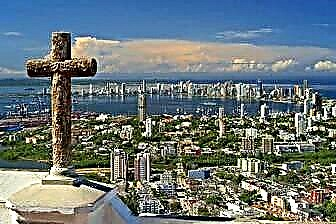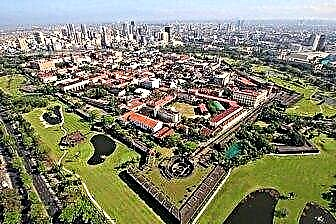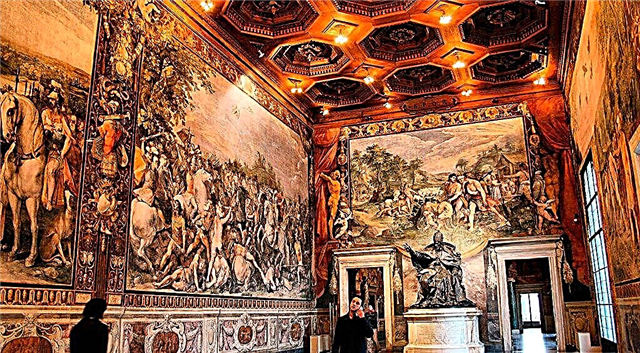The history of Rome is forever frozen in its famous landmarks in the world. The rulers changed, natural and political storms raged. The Romans always found a way out of a difficult situation. Their inquisitive mind, hard work, order helped to solve many technical and economic problems of those times, leaving the heirs, for example, a unique water supply system that is in force today. This applies to works of painting, architecture, sculpture. You can find them in every corner of Rome. Among them is the amazing cultural monument of the Vatican Museum Complex. You can walk on it for a long time, discovering new facts from the ancient life of Italy. Admiring antique sculptures, masterpieces of painting by famous artists from public collections founded in the 18th century by the popes of the Roman Empire Clement XVI and Pius VI. By the way, the beginning of the birth of museums is associated with the discovery of the famous statue "Apollo Belvedere" in 1480 in Anzio.
Construction history
The Vatican State, created in 1929, thanks to Benito Mussolini, despite its small size, has fabulous wealth accumulated in the country. Several dozen museums are located on its square, united into a single complex. Their expositions are occupied by two palaces, other rooms, striking in their architecture. The entire Vatican, located on the hill of the same name, is a huge museum. The ancient Romans considered this place a holy place. Circus games were held here, organized by the order of the Emperor Claudius.
It was a place of mass shows, horse races, chariot competitions. It became a shrine after the burial of the Apostle Christ Saint Peter, who was sentenced to death by the emperor Nero. The history of Christianity is associated with the place. She, as if alive, having come from legends, tales, sparkling architecture of churches, basilicas, temples, attracts tourists from all over the world.
See the ancient frescoes "The Creation of Adam", "The Last Judgment" by Michelangelo in the Sistine Chapel. Imagine how, since the 15th century, the great words “we have a pope” sound after long elections held by cardinals. Even white smoke rises from the chimney in honor of the successful end of the elections, as if many centuries ago.
The priceless treasures of the Vatican are carefully preserved in numerous museums united in the complex. The number of museums in the area of a small country is about 200. About 30 entered the museum complex, which is one of the most significant museums in the world. It takes a lot of time to look closely at the treasures acquired over the centuries.
What museums are included in the complex

The sights of the Vatican are located behind the medieval fortress wall of the state in the state, erected in the 9th century. Their number is constantly increasing. Palaces, cathedrals, Vatican gardens, art galleries, administrative buildings of the universities of Urbana, Thomas Aquinas, the residence of the popes, and a radio station rise on the State Square. The complex includes the following attractions.
Egyptian Museum. The museum was opened in mid-1839 based on the wishes of Gregory XVI. Elements of Egyptian art are collected here. They were collected by Pope Pius VII. Statues, rich sarcophagi, ancient sculptures, papyri, mummies, were delivered from the collections of private owners, archaeological excavations during the capture of Egypt.
They are considered the centerpieces of the museum. The museum's expositions occupy nine halls. Their design matches the Egyptian style. Among the ancient artifacts are the stele of the woman-pharaoh, the head of Amenhotep (21st century BC), the statue of Ramses II, numerous burial urns of the great people of antiquity.
Etruscan Museum. In 22 departments, a huge number of finds from the necropolises of the ancient settlements of Etruria, located near the city of Cerveteri, are collected. The museum was opened in 1837. Its rooms are decorated with frescoes showing scenes from the Old Testament. The museum's expositions contain unique silver and gold items. Ancient samples of ceramics, household items made in the 7th century BC. One compartment contains the full equipment of the ancient warriors of the 4th century BC. Of interest is a hall with urns for burial, tuff sarcophagi with images of scenes from the mythology of Ancient Greece. Now one of the halls is being updated, which will show what the Etruscan temple was like.
Ethnological Missionary Museum. The beginning of work is associated with the holding of the International Missionary Exhibition in 1925. On the territory of the Vatican Gardens there are 24 pavilions with elements of religious worship. They were brought here from different parts of the world. A large number of artifacts were donated to the pontiff by the Catholic Church. Subsequently, their number increased. A large museum began to develop on their basis. The building, erected in 1963, houses almost 100,000 interesting exhibits from different parts of the planet.
Museum of Secular Art. The Gregorian Museum was opened in 1970. It contains the antique art treasures found in the state. Among them are statues of ancient gods.

Pio Clementno Museum. It was created at the suggestion of Pope Clement XIV in 1769. It is dedicated to the artifacts of ancient art of Rome and Greece, which are located in the halls, the courtyard of the museum. The courtyard is in the shape of an octagon, surrounded by a port with 16 columns. The statues are installed in the depths of the niches. Among them, the following niches are best known:
- Laocoon. The sculpture is made of marble in the 1st century, restored by Michelangelo Buanarotti. The scene from the Aeneid, in which the priest Laocoon and his sons are fighting two sea serpents, reflects Athena's revenge for the fact that Laocoon tried to enter Troy inside a horse. The sculptural group has played a role in shaping a generation of craftsmen, amazed at the details used to depict the male body. Many famous works have appeared under the inspiration that fills the work of Laocoon. The statue has a complex history. During the victory of Napoleon, it was exported from Italy and kept in the Louvre's expositions. After returning home, the statue's right arm was restored in 1906.
- Canova. The work is named after the author who depicted a copy from the original of the damaged statue of the Greek Perseus, decorated with ancient attributes in the form of the helmet of Hades, the sandals of Hermes, the head of Medusa, the sword of Hephaestus
- Apollo Belvedere. The niche contains a copy of a bronze creation by the sculptor Leochares, who lived in ancient Greece in the 4th century BC
- Hermes. Copy of an ancient Greek statue created by Praxiteles in the 4th century BC
The infrastructure of the museum is replete with numerous galleries, halls, for example:
- Hall of muses. Its main decoration is frescoes depicting Apollo, muses. They were created in the 18th century by Tommaso Conca. The creation of the hall was conceived for the storage of sculptures found in the villas of Cassia, Tivoli
- Round hall. Its shape is similar to that of the Parthenon, and the floor is decorated with mosaics depicting sea monsters, heroes from the myths of Rome. The mosaic floor was created at the beginning of the 2nd century BC, found in the town of Umbria. A copy of the statue of Neptune, made by the Greek Briassis in the 4th century BC, was also brought from this place. In the center of the hall is Nero's giant pool. Statues are installed along its perimeter. Among them is the bronze creation of Hercules, created in the II century BC
- Hall of animals. It features a collection of sculptures, ancient animal mosaics
- Hall of the Greek Cross. The exposition of the hall acquaints with the amazing ancient sarcophagi of famous names. For example, the sarcophagus of the mother of Emperor Constantine Helena, granddaughter of Constantine
- Gallery of statues. A lot of them. They all have history and interesting legends.A sculpture of the sleeping Arianna, daughter of King Minos, which inspired many artists and was bought by Pope Julius II in 1512. For a long time it was assumed that this is Cleopatra, who gave herself to be bitten by a deadly viper.
The Gallery of Masks, the Halls of Perseus, Apoxyomenos, the Rotunda, the Gallery of Busts are filled with interesting artifacts, works of art from different times in the Pio Clementio Museum.
Raphael's Stanzas. Otherwise, the rooms of a famous artist. They signed them together with the students in the period 1508-1517. All of them have a thematic focus of the paintings. For example, similar to the frescoes "Fire in Bogro", "The Athenian School", "Wisdom, Moderation and Strength", "The Expulsion of Eliodorus", "The Exposition of Peter". Stanzas served for court sessions, church tribunals, and receiving guests. The vaults of the aisles of the palace (Raphael Loggia) are decorated with frescoes by Raphael Santi on the themes of the Old, New Testaments.

Vatican Pinakothek. A rare collection of European, Byzantine painting of the XI-IXX centuries is located in a separate building, erected in 1932. The Pinakothek was founded at the end of the 18th century, when, at the request of Pope Pius VI, his collection of paintings settled in a specific place. Now it has covered 18 rooms, consists of paintings created by masters of Italy on the theme of religion. These are the famous names Titian, Rfafael, Caravaggio, Leonardo da Vinci, Poussin, and others. Separate rooms are dedicated to the works of artists from schools of Flemish, Baroque, Dutch, Florentine painting. The Pinakothek contains masterpieces of icons, sculptures, tapestries, mosaics.
Gallery of Aration or tapestries. The gallery was opened in 1838. The famous tapestries are based on sketches by famous artists on biblical themes. Among them are tapestries, made according to the works of the Flemish Peter Cook bath Alst "The Beating of the Babies", "Resurrection", Adoration of the Shepherds ". Previously, many were kept in the Sistine Chapel.

The Chiaromonti Museum, the Borgia Apartments, the Gregorian Museum of Secular Art, the Historical Museum, galleries of candelabra, maps and other unique places are included in the complex.
Opening hours and ticket prices
The museums are open all week except Sundays. They open at 9:00 am. The closure of the museum takes place at 18:00, but tickets at the box office are sold until 16:00. The museum complex is located in Rome at Viale Vaticano. It is convenient to admire the treasures of the museum by purchasing a single ticket for 16 EUR.
Where is the complex and how to get there
You do not need to apply for a special visa to travel to the Vatican State. A Schengen visa to Italy, obtained, for example, at the Russian embassy of Italy, allows you to fly to the capital of the country. From the main airport, you are invited to come to the Vatican by the Leonardo train, which leaves in half an hour from the railway station located in the airport square. The ticket price is € 14. At Roma Termini Central Station, take the Orange Metro Line. Get off at the Vatican Museums station. Tickets are punched before boarding. There is an option to travel only by metro from the train departure station. It will take longer.











